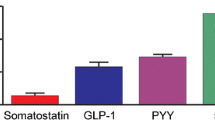Summary
The duodenal and colonic epithelia in mice were observed with electron microscopic autoradiography 2, 5 and 24 hours after a single injection of 3H-thymidine. After 2 hours, in the duodenum, silver grains are found in many undifferentiated cells, in a few young goblet cells, in some crystal-containing cells, and in some lymphocytes. In the colon after 2 hours silver grains are seen in some undifferentiated cells, and in many young goblet cells. Undifferentiated cells are characterized by a few short microvilli, poorly developed rough-surfaced endoplasmic reticulum, abundant free ribosomes, and a few apical moderately dense granules. In normal animals, absorptive cells seem to arise from undifferentiated cells, and goblet cells — from younger goblet cells. Undifferentiated cells could also become young goblet cells. Crystal-containing cells, which may not be of epithelial origin, proliferate in the epithelium in the adult animal.
Similar content being viewed by others
References
Deschner, E. E.: Observations on the Paneth cell in human ileum. Exp. Cell Res. 47, 624–628 (1967).
Hooper, C. E. S.: Cell turnover in epithelial populations. J. Histochem. Cytochem. 4, 531–540 (1956).
Kaku, H., Kojima, A., Hayashi, K., Horii, M., Nakamura, K., Fujita, S.: Analytical studies on the cytodynamics of the intestinal epithelium. Arch. histol. jap. 23, 7–19 (1962).
—, Masu, S., Fujita, S.: Cytokinetics of developing intestine. Arch. histol. jap. 23, 375–381 (1963).
Leblond, C. P.: The time dimension in histology. Amer. J. Anat. 116, 1–27 (1965).
—, Messier, B.: Renewal of chief cells and goblet cells in the small intestine as shown by radioautography after injection of thymidine-H3 into mice. Anat. Rec. 132, 247–258 (1958).
Merzel, J., Leblond, C. P.: Renewal of goblet cells in the small intestine of the mouse. Anat. Rec. 160, 393–394 (1968).
Messier, B., Leblond, C. P.: Cell Proliferation and migration as revealed by radioautography after injection of thymidine-H3 into male rats and mice. Amer. J. Anat. 106, 247–285 (1960).
Silva, D. G.: The ultrastructure of crystal-containing cells in the colonic epithelium of mice. J. Ultrastruct. Res. 18, 127–141 (1967).
Toner, P. G.: The fine structure of the globule leucocyte in the fowl intestine. Acta anat. (Basel) 61, 321–330 (1965).
Troughton, W. D., Trier, J. S.: Paneth and goblet cell renewal in mouse duodenal crypts. J. Cell Biol. 41, 251–268 (1969).
Author information
Authors and Affiliations
Rights and permissions
About this article
Cite this article
Kataoka, K. The fine structure of the proliferative cells of the mouse intestine as revealed by electron microscopic autoradiography with 3H-thymidine. Z. Zellforsch. 103, 170–178 (1970). https://doi.org/10.1007/BF00337310
Received:
Issue Date:
DOI: https://doi.org/10.1007/BF00337310



